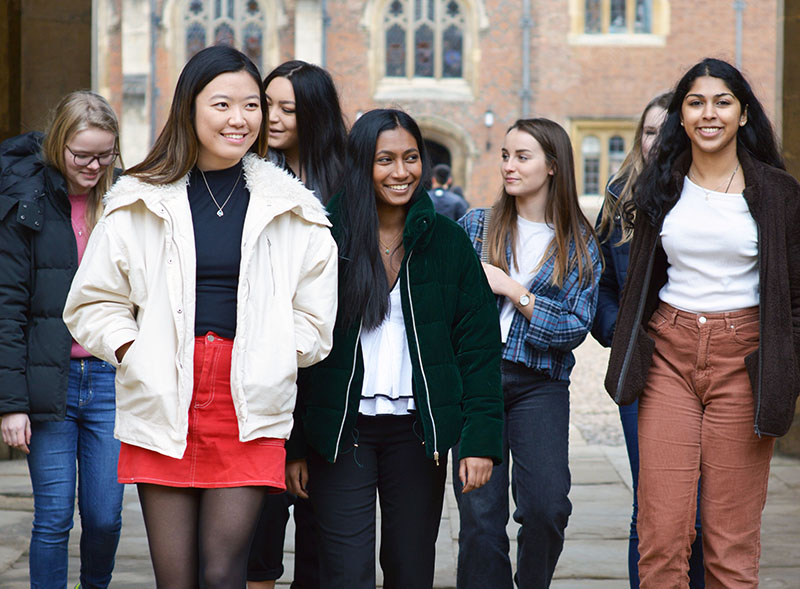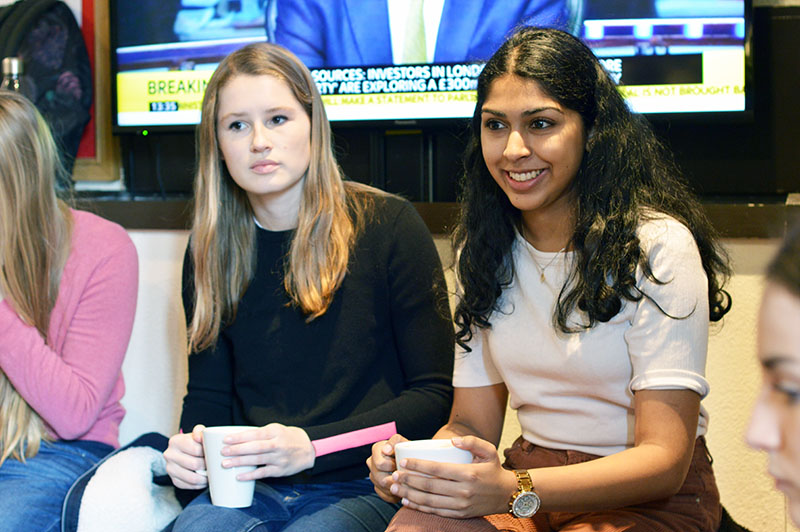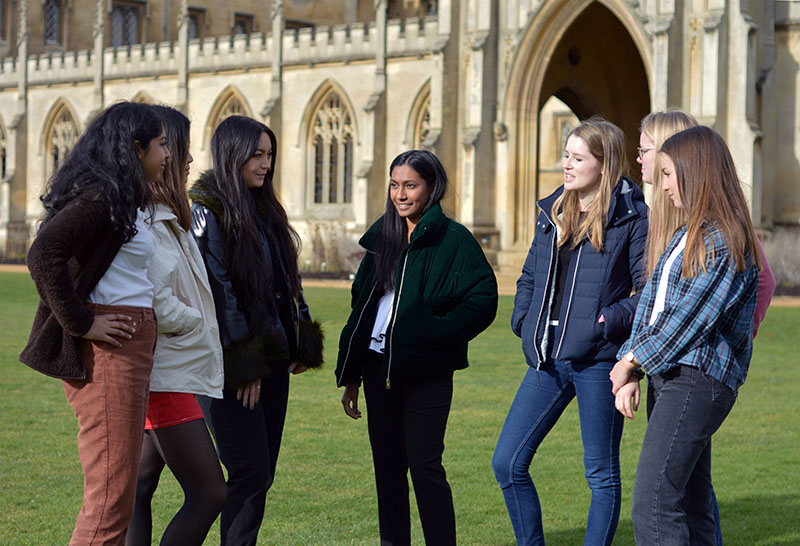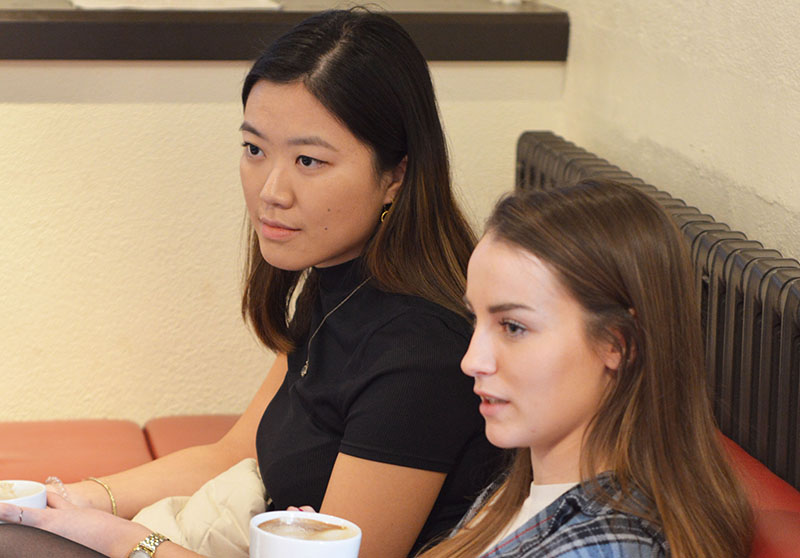Women of the JCR
"I love St John’s and the people in it, but there are things about the view people hold of the College that I want to change”
When Sharon Chen Cooper, the first female undergraduate student to be admitted to St John’s, arrived in 1982 the flag was flying at half-mast and the Head Porter was wearing a black armband. Jo Tynan meets the female members of the Junior Combination Room (JCR) committee to find out how life has changed.
Trekking across the courts in search of a toilet is thankfully a thing of the past for female undergraduates at St John’s, but with male students still (just) outnumbering women, Anusha Ashok, the new Co-President of the JCR, is determined to make a difference.
The second year Maths student only decided to run for the role of leading the JCR Committee a week before the elections, and together with Ollie Barnard, a second year engineer, the pair were elected as Co-Presidents with a resounding majority of student votes.

The female members of the JCR in Third Court
"Knowing how male-dominated St John’s has been in the past is motivating because it gives us the drive to make our mark”
Anusha explained: “I love St John’s and the people in it, but there are things that annoyed me about the view that people held of St John’s and I want that to change. I also want undergrads to become more engaged with student issues at St John’s and University wide issues.
“Ollie is a really good friend of mine and we realised we had similar ideas, ethos and vision so we thought it would be redundant to run against each other so we decided to stand as a pair. We also thought we could get more done together.
“We both want the College to feel less insular, more diverse and representative. St John’s really is a diverse place and we want to showcase that to the rest of Cambridge. And by diverse I mean that in every possible way – race, background, gender.”
The JCR is the student body with an elected committee that organise events and welfare initiatives and represent student voices in College meetings with academics and senior leaders. Anusha is the ninth woman to be elected to lead the JCR since Katharine Newby Grant (née Joy) was the first female voted in as President in 1996 – a statistic that is not lost on the other female members of the committee.
Dani Vijayakumar, a second year Economics student and Academic Affairs and Careers Officer on the JCR, added: “We haven’t had a female JCR President for six or seven years, so having Anusha representing our interests is really important. We had got to the point where we would just assume the next President would be male.
“It is so shocking to us now that women were only admitted in the early 1980s, but knowing how male-dominated St John’s has been in the past is actually really motivating because it gives us the drive to make our mark. Boys are used to being surrounded by people they can look up to and aspire to be and having strong female representation on the JCR Committee really has an impact on the wider community – it makes us want to be at the forefront to spark change.”

Amara and Anush in the College bar
"I feel an added responsibility as a woman of colour to bring issues up that won’t affect many of the people in a room but can affect a minority of people"
Is there an added pressure for Anusha as a woman in the role as President?
Anusha replied: “Standing out in a room of academics can initially be really intimidating but it can also highlight how important it is for your voice to be heard. I particularly feel an added responsibility as a woman of colour to bring issues up that won’t affect many of the people in a room but can affect a minority of people in College.”
Anusha would like unconscious bias training to be introduced at St John’s to help improve the student experience. Unconscious bias training explores how people can sometimes act on snap judgments based on the other person’s race, sex or background without any conscious intention.
“In this role I can get those issues heard and instigate something tangible that can make a difference to make sure no one feels marginalised – I feel I am able to bring a fresh new perspective to meetings. College is a lot more collaborative than I was expecting and the College Officers listen a lot to our experiences – it has been really positive so far.”
Discovering how receptive the College has been to the viewpoints of the JCR and the willingness to explore solutions is something the group of women JCR officers all praised.
Emma Li, Secretary of the JCR, attends weekly meetings with Cambridge University Students’ Union (CUSU) and noticed that JCR members from other Colleges report that Fellows can be reluctant to work with students and listen to their concerns and ideas.
She said: “They are often at war over issues that are important to them, fortunately we don’t have anything like that at St John’s – quite the opposite.”

Dani Vijayakumar, Academic Affairs and Careers Officer, in the centre, with the other female members of the JCR committee
“The Master is amazing and genuinely cares about us and our welfare. He is always telling us that ‘you are the College'"
Anusha has regular meetings with Sir Christopher Dobson, the Master of St John’s, and with Dr Annis May Timpson, Director of Education and Senior Tutor, in her role as Co-President and attends College Council committee meetings. She said: “The Master is amazing and genuinely cares about us and our welfare. He is always telling us that ‘you are the College’. We had a two hour meeting with him the other day and he has told us his door is always open if we need him, which means a lot to us.”
Nina Newhouse, Vice President of the JCR and a Geographer, agreed: “He gave a speech in Hall recently and talked about the portraits on the walls and told us how the people featured were just like us once and not sure what they were going to achieve in life. He told us that we are all the future, and that we would go on to do amazing things. It was really inspirational; not everyone knows what they want to do next.”
The group of women all applied directly to St John’s for a variety of reasons ranging from being encouraged by a Johnian Maths teacher who recommended Cambridge to Anusha, to taking part in a Sutton Trust Summer School residential for Leia Henderson. Leia is the JCR Access Officer and works to make John’s accessible for everyone, regardless of background.
St John’s has recently made it compulsory for new undergraduates to attend annual workshops run by the Good Lad Initiative. The workshops are designed to challenge participants to think about the ways gender inequality exists in their lives and communities and to show men that they can be part of instigating positive change. The women feel ‘lad culture’ still exists at Cambridge and Anusha, as one of just 17 per cent of women in her year in the Faculty of Mathematics, spends her days as an undergraduate being in a minority.

Emma Li, Secretary, with Nina Newhouse, Vice President of the JCR committee
“We can’t pretend this issue doesn’t exist and we are working to change that culture"
She said: “We can’t pretend this issue doesn’t exist and we are working to change that culture. Because our sports teams have traditionally performed very well, there is a perception that life at John’s is centred around them, so having more events that aren’t based on sporting success is one thing we plan to do. Changing the photos in the bar so they aren’t just of male sports teams is another. We want to have an open conversation about any concerns people have.”
Female focused events are already run every week by the St John’s Feminist Society, which aims to ‘create a friendly and supportive safe space where people feel comfortable to speak and listen to each other’. And Nina is organising a Formal Hall at St John’s specifically to mark International Women’s Day.
As it is now 2019, Porters, of course, don’t wear black armbands every time they see a woman, the number of female undergraduates now stands at 253 rather than the 43 who matriculated in 1982, and if these women Johnians are indeed the future as the Master predicts, then the legacy of women at St John’s is only going to get even stronger.
Please note, some members of the JCR committee may have changed since this article was written.
Published: 07/03/19